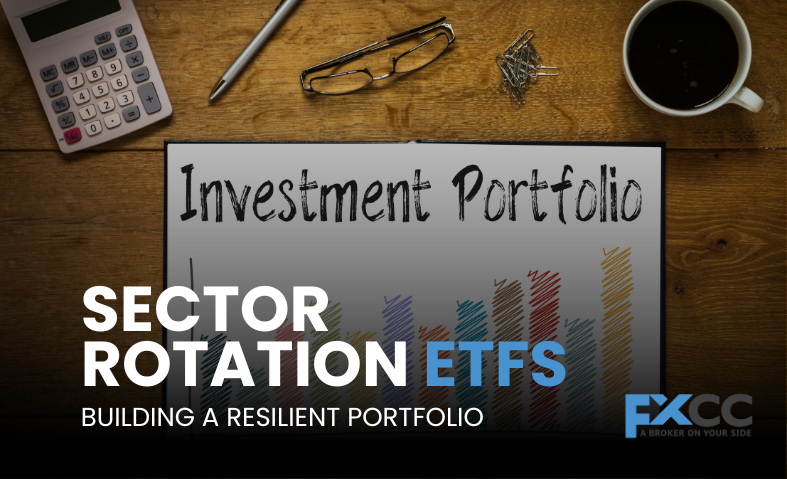Investing often feels like steering a ship through unpredictable waters—calm one day, turbulent the next. The key is learning to ride the waves and make the market’s movements work in your favor. That’s where a well-thought-out strategy like sector rotation can make all the difference. By using Sector Rotation Exchange-Traded Funds (ETFs), you can create a portfolio that adapts to market changes and remains strong even during turbulent times. Unlike a passive approach, sector rotation demands active involvement and regular adjustments.

What Are Sector Rotation ETFs?
To get started, it’s important to understand what Sector Rotation ETFs are. These funds focus on specific sectors of the economy, such as technology, healthcare, energy, or consumer goods. Rather than investing in individual stocks, these ETFs give you exposure to a collection of companies within a single sector, making your investments more diversified and reducing risk.
Sector rotation, on the other hand, refers to the process of shifting investments between these sectors based on where the economy is in its cycle. For instance, when the economy is booming, technology and consumer discretionary sectors often shine. During slower times, defensive sectors like utilities and healthcare come into play.
Why Use Sector Rotation in Your Portfolio?
The economy doesn’t move in one direction—it’s a constant cycle of expansion, peak, contraction, and recovery. Each phase affects sectors differently. By understanding these patterns, you can adjust your investments to take advantage of opportunities while minimizing potential losses.
For instance, during expansion phases, industries like technology and financials usually thrive as consumer and business spending increases. However, when the economy enters a contraction phase, sectors such as healthcare and utilities become more attractive since they provide essential services that people rely on regardless of economic conditions.
A Step-by-Step Guide to Sector Rotation ETFs
Here’s how you can start using sector rotation to build a resilient portfolio:
1. Understand Economic Phases
The economy is like a cycle with four key stages: expansion, peak, contraction, and recovery. Each phase impacts different sectors in unique ways. For instance, during expansion, cyclical sectors like technology and consumer discretionary see strong growth. In a contraction, defensive sectors like utilities and healthcare hold up better.
By identifying which phase the economy is in, you can position your investments accordingly. Pay close attention to economic indicators like GDP growth, unemployment rates, and inflation. These metrics can offer valuable insights into what’s coming next and which sectors are likely to outperform.
2. Research Sector ETFs
Once you understand the economic environment, research the ETFs available for different sectors. Each sector typically has a handful of ETFs to choose from. Look at their holdings, historical performance, and expense ratios. Popular options include the Technology Select Sector SPDR Fund (XLK) and the Health Care Select Sector SPDR Fund (XLV).
Make sure to choose ETFs that align with your strategy, keeping in mind the current economic cycle and your long-term goals.
3. Balance Your Portfolio Across Sectors
While sector rotation focuses on shifting between sectors, it’s important to maintain diversification. Overloading on one sector can expose you to significant risk if the market turns against it. A well-rounded portfolio that includes a mix of cyclical and defensive sectors can help protect your investments against unexpected market downturns.
4. Stay Flexible and Monitor Trends
It’s not a strategy you can adopt and ignore. The key to success lies in staying alert and adjusting your investments as the economic landscape changes. Keep an eye on market trends, earnings reports, and global events that could impact specific sectors. For instance, a rise in interest rates might benefit financials but hurt real estate.
By staying informed, you can make timely adjustments to keep your portfolio resilient and aligned with your financial goals.
Common Pitfalls to Avoid
While sector rotation can be a powerful investment tool, it’s not without its challenges. Avoid these common mistakes:
- Chasing Recent Performance
It’s tempting to jump into a sector that has been performing well recently. However, past performance isn’t always an indicator of future success. Instead, focus on where the economy is heading and invest accordingly. - Overtrading
Switching sectors too frequently can lead to higher transaction costs and reduced returns. Stick to a disciplined approach and avoid making impulsive decisions based on short-term market noise. - Overlooking Fundamentals
Sector rotation is just one piece of the investment puzzle. Don’t forget to consider the overall health and performance of the companies within an ETF before investing. This ensures that you’re not only investing in the right sector but also in quality businesses.
The Benefits of Sector Rotation ETFs
One of the biggest advantages of Sector Rotation ETFs is their flexibility. Unlike mutual funds, ETFs can be traded throughout the day, allowing you to react quickly to market changes. They’re also more cost-effective, with lower fees compared to actively managed funds.
Sector rotation allows you to take advantage of growth opportunities while limiting your exposure to risk. By rotating into sectors likely to perform well based on economic conditions, you can build a portfolio that adapts to changes and thrives over time.

Final Thoughts
Sector rotation ETFs provide a straightforward and effective way to navigate the ever-changing financial landscape. By understanding economic cycles, diversifying your investments, and staying informed, you can create a resilient portfolio that stands the test of time.
Remember, investing is a journey, not a sprint. Start small, keep learning, and adjust your strategy as you gain experience. With time and patience, you’ll find that sector rotation can be a valuable tool for achieving your financial goals.


